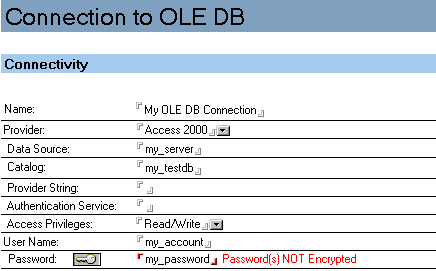Fields in the HEI Connection Document - 7
See the following tables for descriptions of the HCL Enterprise Integrator (HEI) connection document fields.
Connectivity
The Connectivity options are described as follows.

| Field |
Description |
|---|---|
| Name |
Specifies a unique name that identifies this connection. The maximum number of characters allowed is 255. |
| Provider |
Specifies the programmatic ID. The choices are SQL server 2000 and 2005. |
| Data Source |
Specifies the network name of the server running the SQL server database, based on the value specified in the Provider field. See the "Connector for OLE DB Operational Considerations" section for details. |
| Catalog |
Specifies the name of the SQL server database that you want to connect to. See the "Connector for OLE DB Operational Considerations" section for details. |
| Provider String |
Specifies any required provider string values. SQLOLEDB recognizes an ODBC-like syntax in provider string property values. Within the string, elements are delimited by using a semicolon. The final element in the string must be terminated with a semicolon. Each element consists of a keyword, an equal sign character, and the value passed on initialization, for example: Server=Gumby;UID=george; You may need to set network to the name of the Net-Library (DLL) used to communicate with the SQL server. The name should not include the path or the .dll file name extension. For example, to use the TCP/IP network library, add the following: Network=DBMSSOCN; Alternatively, the default Net-Library can be set by the SQL server client network utility. |
| Authentication Service |
If this property is set to "SSPI", SQLOLEDB uses Microsoft™ Windows™ authentication mode to authorize user access to the SQL server database. If it is not set, SQL server security is used. The SQL server login and password are specified in the User Name and Password properties. |
| Access Privileges |
Specifies user access to the database. The choices are as follows.
|
| User Name |
Specifies the user name required to log in to the SQL server. Leave blank if using Windows™ Authentication. Note: If you do not specify a user name and password in the connection document, the Connector will
attempt to use the Microsoft™
Windows™ user name and password of the account logged in on
your HEI server. If that user does not have an account in SQL server, an error message will
appear. |
| Password |
Specifies the password associated with the preceding user name. Leave blank if using Windows™ Authentication. Password encryption is described in the "Introduction to Connectors" chapter. |
Connection Options
The Connection Options section provides options for managing data transactions, creating tables, and logging SQL commands. These settings have no effect on Advanced RealTime activities.
Transaction Options
When you select the Transaction Options tab, the following options appear. The Transaction Options apply to operations that create, modify, or delete data.
![]()
| Field |
Description |
|---|---|
| Commit Frequency |
Indicates how often to commit a transaction. If set to 1, all actions are immediately committed. If set to 0 (zero), actions are committed at disconnect. Set this option to 1 for Replication activities. |
| Isolation level |
Determines the extent that outside actions can affect a transaction. The options are as follows:
|
Logging Options
When you select the Logging Options tab, the following options appear. The Logging Options section provides a feature for including SQL statements in the activity log.
![]()
| Field |
Description |
|---|---|
| Output SQL Statements to Log |
Select this option to include in the activity log all SQL statements generated during processing of the activity. Note: Selecting
this option slows down performance. Use it only for troubleshooting. |
Selection Type
Regardless of which Options tab you select, the following option is available.
![]()
| Field |
Description |
|---|---|
| Selection Type |
Enables you to specify the metadata type for a connection.
Spaces in a table or column name are not permitted. |
Table Options
These settings display a current list of tables and allow you to specify which tables will be accessed and how. You can also specify a table name not shown in the list by selecting the Manual button.
![]()
| Field |
Description |
|---|---|
| Owner |
Lists the available owner names for the preceding table, view, or procedure selection type in the specified database. A selection list displays all OLE DB owners. Choose the owner of the table, view, or procedure being connected to from the list (Optional). |
| Name |
Lists the available table, view, or procedure names defined for the specified Owner. Click the down-arrow button to select from the list of available tables, views, or procedures. A selection list displays all OLE DB tables, views, or procedures for the selected Owner. Choose the table, view, or procedure to connect to. If an owner is not specified, all names are listed for the specified selection type. Spaces in a table or column name are not permitted. |
| Column |
Lists the columns or parameters (stored procedure) defined for the specified name. Spaces in a table or column name are not permitted. |